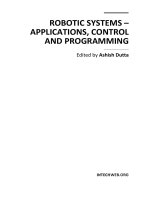07 programming program control instructions
Bạn đang xem bản rút gọn của tài liệu. Xem và tải ngay bản đầy đủ của tài liệu tại đây (144.92 KB, 15 trang )
DAY 2
SESSION 3
7-1
LADDER LOGIC PROGRAMMING – CONTROL
INSTRUCTIONS
Ladder Logic Programming – Control Instructions
6 – 10 December 2010
Instruction
Function (Description)
MCR
Disable all the rungs in a section of logic
JMP, LBL
Jump over a section of logic that does not always need
to be executed
JSR, SBR, RET
Jump to a separate routine, pass data to the routine,
execute the routine, and return results.
TND
Mark a temporary end that halts routine execution.
AFI
Disable a rung.
SFR*
Reset a sequential function chart (SFC)
UIE*, UID*
Disable user tasks
EOT
End a transition for a sequential function chart
Ladder Logic Programming – Control Instructions
6 – 10 December 2010
7-2
PROGRAM CONTROL
INSTRUCTIONS
MCR – MASTER CONTROL RESET
•
The MCR instruction, used in pairs, creates a program zone that can
disable all rungs within the MCR instructions.
•
When the MCR zone is enabled, the rungs in the MCR zone are scanned
for normal true or false conditions.
•
When disabled, the controller still scans rungs within an MCR zone, but
scan time is reduced because all the outputs in the zone are disabled.
•
When the MCR zone is disabled, the rung-condition-in is false for all the
instructions inside of the MCR zone.
•
When you program an MCR zone, note that:
7-3
• User must end the zone with an unconditional MCR instruction.
• User cannot nest one MCR zone within another.
• Do not jump into an MCR zone. If the zone is false, jumping into the zone
activates the zone from the point to which user jumped to the end of the zone.
• If an MCR zone continues to the end of the routine, user do not have to
program an MCR instruction to end the zone.
Ladder Logic Programming – Control Instructions
6 – 10 December 2010
7-4
SAMPLE PROGRAM OF MCR
Ladder Logic Programming – Control Instructions
6 – 10 December 2010
JMP – JUMP DAN LBL – LABEL
The JMP and LBL instructions skip portions of ladder logic.
•
When enabled, the JMP instruction skips to the referenced LBL instruction and
the controller continues executing from there.
•
When disabled, the JMP instruction does not affect ladder execution.
7-5
•
Ladder Logic Programming – Control Instructions
6 – 10 December 2010
JSR – JUMP TO SUBROUTINE, SBR
– SUBROUTINE, AND RET - RETURN
• The JSR instruction jumps execution to a different routine.
• The SBR instruction passes data to and executes a routine.
• The RET instruction returns the results.
• The JSR instruction initiates the execution of the specified
routine, which is referred to as a subroutine:
7-6
• The subroutine executes one time.
• After the subroutine executes, logic execution returns to the
routine that contains the JSR instruction.
Ladder Logic Programming – Control Instructions
6 – 10 December 2010
SAMPLE PROGRAM
Program constant and value are
saved in logical address that
passed to SBR instruction when
JMP being executed to subroutine
file
Next, when subroutine finish,
parameter value return to JSR by
RET instructions
Ladder Logic Programming – Control Instructions
s
c
a
n
7-7
s
c
a
n
6 – 10 December 2010
SUBROUTINE WHICH CONNECTED
There are no restrictions, other than controller memory, on the
number of nested routines user can have, or the number of
parameters user pass or return.
Main Program
JSR U:2
SBR
SBR
U:3
JSR
U:4
U:5
JSR
RET
RET
7-8
RET
SBR
Ladder Logic Programming – Control Instructions
6 – 10 December 2010
TND – TEMPORARY END
• The TND instruction acts as a boundary.
• When enabled, the TND instruction lets the controller execute
logic only up to this instruction.
• When enabled, the TND instruction acts as the end of the
routine.
• When the controller scans a TND instruction, the controller
moves to the end of the current routine.
• If the TND instruction is in a subroutine, control returns to the
calling routine.
7-9
• If the TND instruction is in a main routine, control returns to
the next program within the current task.
Ladder Logic Programming – Control Instructions
6 – 10 December 2010
7-10
This rung will be act as
END instruction in the end
of program.
If I:000/5 goes true, then
TND will be enable and will
be cause the rest rungs will
not be scanned.
Scan
Scan
SAMPLE PROGRAM OF TND
Ladder Logic Programming – Control Instructions
6 – 10 December 2010
AFI – ALWAYS FALSE
• The AFI instruction sets its rung-condition-out to false.
• Use the AFI instruction to temporarily disable a rung while you
are debugging a program.
7-11
• When enabled, the AFI disables all the instructions on this
rung.
Ladder Logic Programming – Control Instructions
6 – 10 December 2010
Scan
SAMPLE PROGRAM
7-12
Always false
Ladder Logic Programming – Control Instructions
6 – 10 December 2010
EOT - END OF TRANSITION
• The EOT instruction returns a Boolean state to an SFC
instruction.
• Because the EOT instruction returns a Boolean state, multiple
SFC routines can share the same routine that contains the
EOT instruction.
• If the calling routine is not a transition, the EOT instruction
acts as a TND instruction.
7-13
• Sample Program of :
Ladder Logic Programming – Control Instructions
6 – 10 December 2010
UID – USER INTERRUPT DISABLE
The UID instruction and the UIE instruction work together to
prevent a small number of critical rungs from being interrupted
by other tasks.
Sample Program of UID :
Interruptible program
Interruptible program
Ladder Logic Programming – Control Instructions
6 – 10 December 2010
7-14
Uninterruptable program
NEXT
SESSION 4
7-15
LADDER LOGIC PROGRAMMING – MATH
INSTRUCTIONS
Ladder Logic Programming – Control Instructions
6 – 10 December 2010









